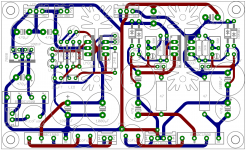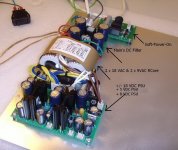May I assist you, Daniel?
I have layouted, soldered and tested a PSU (for a PRE, DAC and Buffer), very, very similar to your one, several weeks ago, but did not put the transformer on the PCB!
(I myself needed a +/-18VDC supply for my Buffer (but - of course - the LM3x7 can be adjusted to +/- 14,25VDC as well!), a +5VDC for a DAC and a supply voltage (+8VDC) for a MICREL 5205 voltage regulator.
I operate the PSU from a R-Core transformer (or whatever you like: Torodial, Print-Transformer, ..., 115VAC or 230VAC, ...)
Specifications: adjustable +/- voltage by means of LM317 / LM337.
Very high precision, "nearly ripple-free" +5VDC supply by means of a LM317 tracking pre-regulator - design and a "rough" +8VDC by means of a 7808 (if needed at all).
I will send you the Gerber -and EAGLE-files, if you like.
I will not offer these PCBs by myself.
Best regards - Rudi_Ratlos
I have layouted, soldered and tested a PSU (for a PRE, DAC and Buffer), very, very similar to your one, several weeks ago, but did not put the transformer on the PCB!
(I myself needed a +/-18VDC supply for my Buffer (but - of course - the LM3x7 can be adjusted to +/- 14,25VDC as well!), a +5VDC for a DAC and a supply voltage (+8VDC) for a MICREL 5205 voltage regulator.
I operate the PSU from a R-Core transformer (or whatever you like: Torodial, Print-Transformer, ..., 115VAC or 230VAC, ...)
Specifications: adjustable +/- voltage by means of LM317 / LM337.
Very high precision, "nearly ripple-free" +5VDC supply by means of a LM317 tracking pre-regulator - design and a "rough" +8VDC by means of a 7808 (if needed at all).
I will send you the Gerber -and EAGLE-files, if you like.
I will not offer these PCBs by myself.
Best regards - Rudi_Ratlos
Attachments
Rudi,
thanks a lot for your kind offer!
However the PSU layout is completely finished and has been sucessfully tested by almost 20 Persons
Due to the onboard transformers the hole unit is quite compact. If someone wants to have more power or needs different primary voltages he can always use external transformers, corresponding pins e.g. for screw type headers are available.
The latest discussion was about either finding onboard transformers for 115V primaries that have the same pin layout and dimensions (would be preferred of course ) or eventually make a second version for different transformers.
) or eventually make a second version for different transformers.
nevertheless, thanks again
@samoloko: You can find an early schematic of the DAC in the thread "Anybody using the new ESS Vout DAC ES9022" post #528. The actual schematic is not exactly the same but quite similar (e.g. different LDOs). Layout has been significantly improved compared to the version shown in this post.
kind regards, Daniel
thanks a lot for your kind offer!
However the PSU layout is completely finished and has been sucessfully tested by almost 20 Persons
Due to the onboard transformers the hole unit is quite compact. If someone wants to have more power or needs different primary voltages he can always use external transformers, corresponding pins e.g. for screw type headers are available.
The latest discussion was about either finding onboard transformers for 115V primaries that have the same pin layout and dimensions (would be preferred of course
nevertheless, thanks again
@samoloko: You can find an early schematic of the DAC in the thread "Anybody using the new ESS Vout DAC ES9022" post #528. The actual schematic is not exactly the same but quite similar (e.g. different LDOs). Layout has been significantly improved compared to the version shown in this post.
kind regards, Daniel
Quite some time ago I did some successful tests with I2S connection from 2x8 board to external DACs. I used an early rev of the 2x8 board though (probably v1.0) which had dedicated test points for I2S signals on board. Not sure if later revs have this test points too. Maybe someone can have a look?
Also keep in mind that I2S interface connections need to be as short as possible (most probably not possible to place the DACs besides the 2x8 board).
Therefore the 2x8 board certainly isn't the ideal option for an upgrade to be honest. Latest version of nanoDIGI (has dedicated I2S header) or miniSHARC seems to be the better option.
kind regards, Daniel
Also keep in mind that I2S interface connections need to be as short as possible (most probably not possible to place the DACs besides the 2x8 board).
Therefore the 2x8 board certainly isn't the ideal option for an upgrade to be honest. Latest version of nanoDIGI (has dedicated I2S header) or miniSHARC seems to be the better option.
kind regards, Daniel
Yes, the PSU works fine for up to four DACs (probably even more).Daniel did you mentioned that one PSU can supply 2-3 DACs without any problem or interference?
kind regards, Daniel
So to all of you from the US wanting PSU Boards:
The PSU Layout is designed to carry a 220V Transformator as you can see in the Shopping Cart (BOM) from reichelt.de. If you want to use the PSU PCB in the USA then you need to find a Transformator with the same footprint like the ones in the Shoping Cart (BOM) from reichelt so it fits directly on the PSU Board or you have to connect a different Transformator directly to the optional connectors labeled as "Low volt AC in".
And also if you are from the USA and wanting a currymanDAC you need to know that we are not sending the DACs to the USA because it will be cheaper if you order it directly from miniDSP.
Just a reminder for those who didn't read the first post entirely!
The PSU Layout is designed to carry a 220V Transformator as you can see in the Shopping Cart (BOM) from reichelt.de. If you want to use the PSU PCB in the USA then you need to find a Transformator with the same footprint like the ones in the Shoping Cart (BOM) from reichelt so it fits directly on the PSU Board or you have to connect a different Transformator directly to the optional connectors labeled as "Low volt AC in".
And also if you are from the USA and wanting a currymanDAC you need to know that we are not sending the DACs to the USA because it will be cheaper if you order it directly from miniDSP.
Just a reminder for those who didn't read the first post entirely!
- Status
- This old topic is closed. If you want to reopen this topic, contact a moderator using the "Report Post" button.
- Home
- Group Buys
- GB for currymanDAC & PSU Boards

